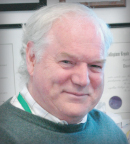This year’s Nobel Prize in Physiology or Medicine was awarded to three scientists who have made a decisive contribution to the treatment of blood-borne hepatitis, a major global health problem that causes cirrhosis and liver cancer in people around the world. Harvey J. Alter, MD; Michael Houghton, PhD, DSc Hon; and Charles M. Rice, PhD, made seminal discoveries that led to the identification of the hepatitis C virus.

Harvey J. Alter, MD

Michael Houghton, PhD, DSc Hon

Charles M. Rice, PhD
Prior to their work, the discovery of the hepatitis A and B viruses had been critical steps forward, but the majority of blood-borne hepatitis cases remained unexplained. The discovery of hepatitis C virus revealed the cause of the remaining cases of chronic hepatitis and made possible blood tests and new medicines that have saved millions of lives. Hepatitis is mainly caused by viral infections, although alcohol abuse, environmental toxins, and autoimmune disease are also important causes. In the 1940s, it became clear that there are two main types of infectious hepatitis.
The first, named hepatitis A, is transmitted by polluted water or food and generally has little long-term impact on the patient. The second type (encompassing both hepatitis B and hepatitis C) is transmitted through blood and bodily fluids and represents a much more serious threat, since it can lead to a chronic condition, with the development of cirrhosis and liver cancer. With this type of hepatitis, otherwise healthy individuals can be silently infected for many years before serious complications arise. Blood-borne hepatitis is associated with significant morbidity and mortality and causes more than a million deaths per year worldwide, thus making it a global health concern on a scale comparable to human immunodeficiency virus and tuberculosis.
Unknown Source of Infections
The key to successful intervention against infectious diseases is to identify the causative agent. In the 1960s, Baruch Blumberg, MD, DPhil, determined that one type of blood-borne hepatitis was caused by a virus that became known as hepatitis B virus, and the discovery led to the development of diagnostic tests and an effective vaccine. Dr. Blumberg was awarded the Nobel Prize in Physiology or Medicine in 1976 for this discovery.
At that time, Dr. Alter was studying the occurrence of hepatitis in patients who had received blood transfusions at the National Institutes of Health. Although blood tests for the newly discovered hepatitis B virus reduced the number of cases of transfusion-related hepatitis, Dr. Alter and colleagues demonstrated that a large number of cases remained. Tests for hepatitis A virus infection were also developed around this time, and it became clear that hepatitis A was not the cause of these unexplained cases.
It was a great source of concern that a significant number of those receiving blood transfusions developed chronic hepatitis due to an unknown infectious agent. Dr. Alter and his colleagues showed that blood from these patients with hepatitis could transmit the disease to chimpanzees, the only susceptible host besides humans. Subsequent studies also demonstrated that the unknown infectious agent had the characteristics of a virus. Dr. Alter’s methodic investigations had in this way defined a new, distinct type of chronic viral hepatitis. The mysterious illness became known as “non-A, non-B” hepatitis.
Identification of Hepatitis C
Identification of the novel virus was now a high priority. All the traditional techniques for virus hunting were put to use but, in spite of this, the virus eluded isolation for more than a decade.
Dr. Houghton, working for the pharmaceutical firm Chiron, undertook the arduous work needed to isolate the genetic sequence of the virus. He and his colleagues created a collection of DNA fragments from nucleic acids found in the blood of an infected chimpanzee. The majority of these fragments came from the genome of the chimpanzee itself, but the researchers predicted that some would be derived from the unknown virus.
On the assumption that antibodies against the virus would be present in blood taken from patients infected with hepatitis, the investigators used patient sera to identify cloned viral DNA fragments encoding viral proteins. Following a comprehensive search, one positive clone was found. Further work showed that this clone was derived from a novel RNA virus belonging to the Flavivirus family, and it was named hepatitis C virus. The presence of antibodies in patients with chronic hepatitis strongly implicated this virus as the missing agent.
The discovery of hepatitis C virus was decisive; but one essential piece of the puzzle was missing: Could the virus alone cause hepatitis? To answer this question the scientists had to investigate whether the cloned virus was able to replicate and cause disease. Dr. Rice, then a researcher at Washington University in St. Louis, along with other groups working with RNA viruses, noted a previously uncharacterized region in the end of the hepatitis C virus genome that they suspected may be important for virus replication. He also observed genetic variations in isolated virus samples and hypothesized that some of them might hinder virus replication.
Through genetic engineering, Dr. Rice generated an RNA variant of the hepatitis C virus that included the newly defined region of the viral genome and was devoid of the inactivating genetic variations. When this RNA was injected into the liver of chimpanzees, the virus was detected in the blood, and pathologic changes resembling those seen in humans with the chronic disease were observed. This was the final proof that the hepatitis C virus alone could cause the unexplained cases of transfusion-mediated hepatitis.
The Nobel Laureates’ discovery of the hepatitis C virus is a landmark achievement in the ongoing battle against viral diseases. Thanks to their discovery, highly sensitive blood tests for the virus are now available; they have essentially eliminated posttransfusion hepatitis in many parts of the world, greatly improving global health. Their discovery also allowed the rapid development of antiviral drugs directed at hepatitis C. For the first time in history, the disease can now be cured, raising hopes of eradicating the virus from the world population.
More on the Laureates
Dr. Alter was born in 1935 in New York. He received his medical degree at the University of Rochester Medical School and trained in internal medicine at Strong Memorial Hospital and at the University Hospitals of Seattle. In 1961, he joined the National Institutes of Health (NIH) as Clinical Associate. He spent several years at Georgetown University before returning to the NIH in 1969 to join the Clinical Center’s Department of Transfusion Medicine as Senior Investigator.
Dr. Houghton was born in the United Kingdom. He received his PhD degree in 1977 from King’s College London. He joined G.D. Searle & Company before moving to Chiron Corporation in 1982. He relocated to the University of Alberta in 2010 and is currently Canada Excellence Research Chair in Virology and the Li Ka Shing Professor of Virology at the University of Alberta.
Dr. Rice was born in 1952 in Sacramento. He received his PhD degree in 1981 from the California Institute of Technology, where he also trained as a postdoctoral fellow between 1981 and 1985. He established his research group at Washington University School of Medicine, St. Louis, in 1986, and became full Professor in 1995. Since 2001, he has been Professor at the Rockefeller University. From 2001 to 2018, he was Scientific and Executive Director of the Center for the Study of Hepatitis C at Rockefeller University.

